 | ||
What are ceramides
Ceramides are a family of waxy lipid molecules. A ceramide is composed of sphingosine and a fatty acid. Ceramides are found in high concentrations within the cell membrane of cells, since they are component lipids that make up sphingomyelin, one of the major lipids in the lipid bilayer. Contrary to previous assumptions that ceramides and other sphingolipids found in cell membrane were purely supporting structural elements, ceramide can participate in a variety of cellular signaling: examples include regulating differentiation, proliferation, and programmed cell death (PCD) of cells.
Contents
- What are ceramides
- Elizabeth arden ceramide
- Pathways for ceramide synthesis
- Sphingomyelin hydrolysis
- De novo
- Salvage pathway
- Physiological roles of ceramide
- Apoptosis
- Skin
- Hormonal
- Substances known to induce ceramide generation
- Mechanism by which ceramide signaling occurs
- Uses
- References
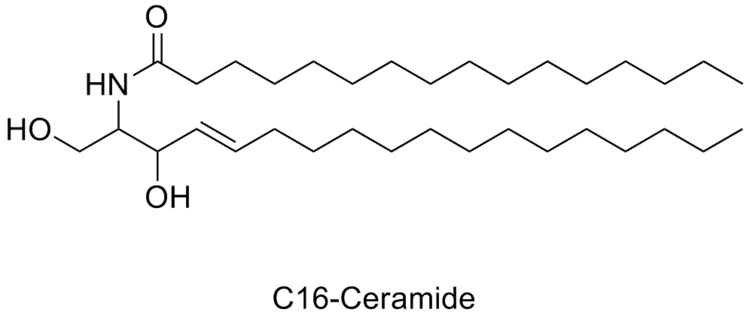
The word ceramide comes from the Latin cera (wax) and amide. Ceramide is a component of vernix caseosa, the waxy or cheese-like white substance found coating the skin of newborn human infants.
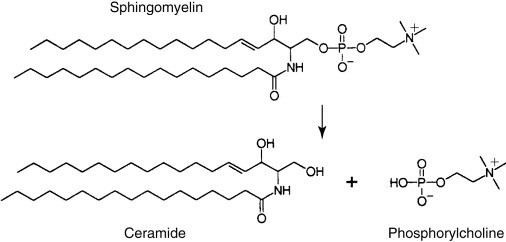
Elizabeth arden ceramide
Pathways for ceramide synthesis

There are three major pathways of ceramide generation. The sphingomyelinase pathway uses an enzyme to break down sphingomyelin in the cell membrane and release ceramide. The de novo pathway creates ceramide from less complex molecules. Ceramide generation can also occur through breakdown of complex sphingolipids that are ultimately broken down into sphingosine, which is then reused by reacylation to form ceramide. This latter pathway is termed the Salvage pathway.
Sphingomyelin hydrolysis

Hydrolysis of sphingomyelin is catalyzed by the enzyme sphingomyelinase. Because sphingomyelin is one of the four common phospholipids found in the plasma membrane of cells, the implications of this method of generating ceramide is that the cellular membrane is the target of extracellular signals leading to programmed cell death. There has been research suggesting that when ionizing radiation causes apoptosis in some cells, the radiation leads to the activation of sphingomyelinase in the cell membrane and ultimately, to ceramide generation.
De novo
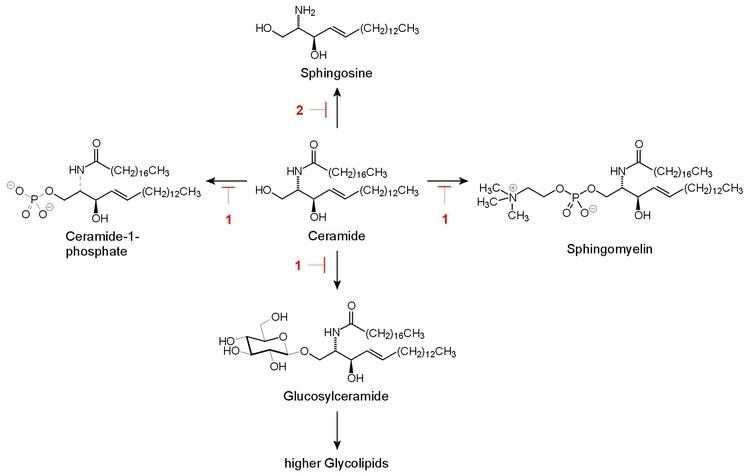
De novo synthesis of ceramide begins with the condensation of palmitate and serine to form 3-keto-dihydrosphingosine. This reaction is catalyzed by the enzyme serine palmitoyl transferase and is the rate-limiting step of the pathway. In turn, 3-keto-dihydrosphingosine is reduced to dihydrosphingosine, which is then followed by acylation by the enzyme (dihydro)ceramide synthase to produce dihydroceramide. The final reaction to produce ceramide is catalyzed by dihydroceramide desaturase. De novo synthesis of ceramide occurs in the endoplasmic reticulum. Ceramide is subsequently transported to the Golgi apparatus by either vesicular trafficking or the ceramide transfer protein CERT. Once in the Golgi apparatus, ceramide can be further metabolized to other sphingolipids, such as sphingomyelin and the complex glycosphingolipids.
Salvage pathway
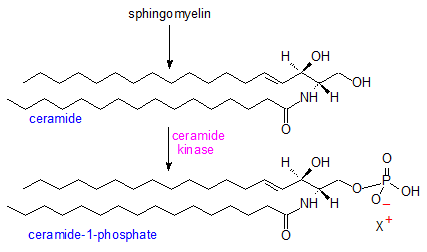
Constitutive degradation of sphingolipids and glycosphingolipids takes place in the acidic subcellular compartments, the late endosomes and the lysosomes, with the end goal of producing sphingosine. In the case of glycosphingolipids, exohydrolases acting at acidic pH optima cause the stepwise release of monosaccharide units from the end of the oligosaccharide chains, leaving just the sphingosine portion of the molecule, which may then contribute to the generation of ceramides. Ceramide can be further hydrolyzed by acid ceramidase to form sphingosine and a free fatty acid, both of which are able to leave the lysosome, unlike ceramide. The long-chain sphingoid bases released from the lysosome may then re-enter pathways for synthesis of ceramide and/or sphingosine-1-phosphate. The salvage pathway re-utilizes long-chain sphingoid bases to form ceramide through the action of ceramide synthase. Thus, ceramide synthase family members probably trap free sphingosine released from the lysosome at the surface of the endoplasmic reticulum or in endoplasmic reticulum-associated membranes. It should also be noted that the salvage pathway has been estimated to contribute from 50% to 90% of sphingolipid biosynthesis
Physiological roles of ceramide

As a bioactive lipid, ceramide has been implicated in a variety of physiological functions including apoptosis, cell growth arrest, differentiation, cell senescence, cell migration and adhesion. Roles for ceramide and its downstream metabolites have also been suggested in a number of pathological states including cancer, neurodegeneration, diabetes, microbial pathogenesis, obesity, and inflammation.
Apoptosis
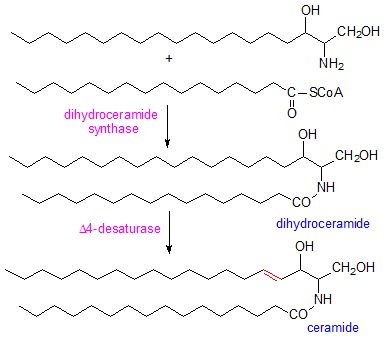
One of the most studied roles of ceramide pertains to its function as a proapoptotic molecule. Apoptosis, or Type I programmed cell death, is essential for the maintenance of normal cellular homeostasis and is an important physiological response to many forms of cellular stress. Ceramide accumulation has been found following treatment of cells with a number of apoptotic agents including ionizing radiation, UV light, TNF-alpha, and chemotherapeutic agents. This suggests a role for ceramide in the biological responses of all these agents. Because of its apoptosis-inducing effects in cancer cells, ceramide has been termed the “tumor suppressor lipid” . Several studies have attempted to define further the specific role of ceramide in the events of cell death and some evidence suggests ceramide functions upstream of the mitochondria in inducing apoptosis. However, owing to the conflicting and variable nature of studies into the role of ceramide in apoptosis, the mechanism by which this lipid regulates apoptosis remains elusive.
Skin
Ceramide is the main component of the stratum corneum of the epidermis layer of human skin. Together with cholesterol and saturated fatty acids, ceramide creates a water-impermeable, protective organ to prevent excessive water loss due to evaporation as well as a barrier against the entry of microorganisms. With aging there is a decline in ceramide and cholesterol in the stratum corneum of humans.
Hormonal
Increased ceramide synthesis leads to both leptin resistance and insulin resistance by increasing SOCS-3 expression. Elevated level of ceramide results in the inhibition of insulin signal transduction pathway and the serine phosphorylation of JNK, leading to insulin resistance.
Substances known to induce ceramide generation
Mechanism by which ceramide signaling occurs
Currently, the means by which ceramide acts as a signaling molecule are not clear.
One hypothesis is that ceramide generated in the plasma membrane enhances membrane rigidity and stabilizes smaller lipid platforms known as lipid rafts, allowing them to serve as platforms for signalling molecules. Moreover, as rafts on one leaflet of the membrane can induce localized changes in the other leaflet of the bilayer, they can potentially serve as the link between signals from outside the cell to signals to be generated within the cell.
Ceramide has also been shown to form organized large channels traversing the mitochondrial outer membrane. This leads to the egress of proteins from the intermembrane space.
Uses
Ceramides may be found as ingredients of some topical skin medications used to complement treatment for skin conditions such as eczema. They are also used in cosmetic products such as some soaps, shampoos, skin creams, and sunscreens. Additionally, ceramides are being explored as a potential therapeutic in cancer.
